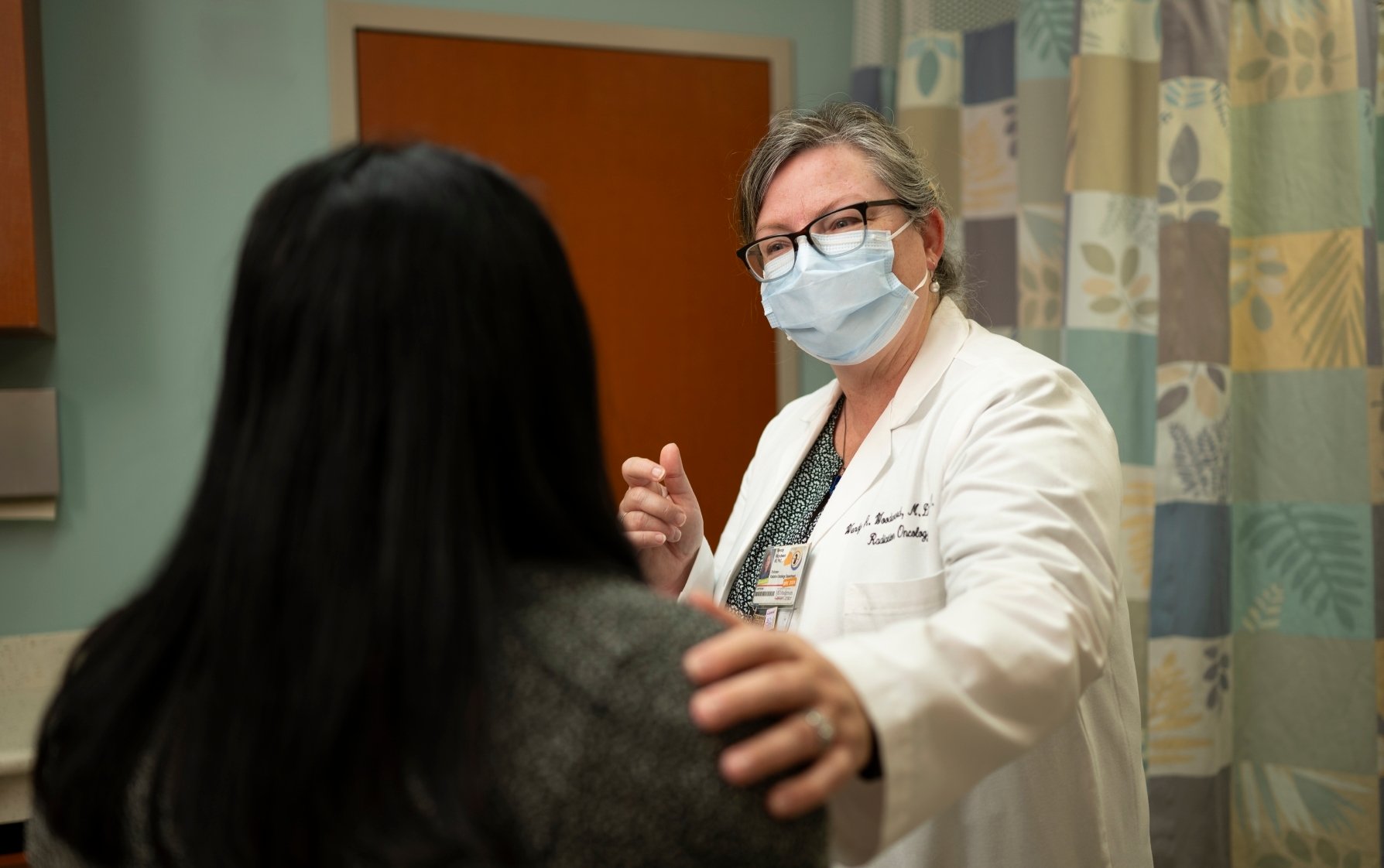- Diseases
- Acoustic Neuroma (16)
- Adrenal Gland Tumor (24)
- Anal Cancer (70)
- Anemia (2)
- Appendix Cancer (18)
- Bile Duct Cancer (26)
- Bladder Cancer (74)
- Brain Metastases (28)
- Brain Tumor (234)
- Breast Cancer (726)
- Breast Implant-Associated Anaplastic Large Cell Lymphoma (2)
- Cancer of Unknown Primary (4)
- Carcinoid Tumor (8)
- Cervical Cancer (164)
- Colon Cancer (168)
- Colorectal Cancer (118)
- Endocrine Tumor (4)
- Esophageal Cancer (44)
- Eye Cancer (36)
- Fallopian Tube Cancer (8)
- Germ Cell Tumor (4)
- Gestational Trophoblastic Disease (2)
- Head and Neck Cancer (14)
- Kidney Cancer (130)
- Leukemia (342)
- Liver Cancer (50)
- Lung Cancer (286)
- Lymphoma (278)
- Mesothelioma (14)
- Metastasis (30)
- Multiple Myeloma (100)
- Myelodysplastic Syndrome (60)
- Myeloproliferative Neoplasm (6)
- Neuroendocrine Tumors (16)
- Oral Cancer (102)
- Ovarian Cancer (178)
- Pancreatic Cancer (160)
- Parathyroid Disease (2)
- Penile Cancer (14)
- Pituitary Tumor (6)
- Prostate Cancer (150)
- Rectal Cancer (58)
- Renal Medullary Carcinoma (6)
- Salivary Gland Cancer (14)
- Sarcoma (238)
- Skin Cancer (300)
- Skull Base Tumors (56)
- Spinal Tumor (12)
- Stomach Cancer (66)
- Testicular Cancer (28)
- Throat Cancer (92)
- Thymoma (6)
- Thyroid Cancer (100)
- Tonsil Cancer (30)
- Uterine Cancer (86)
- Vaginal Cancer (18)
- Vulvar Cancer (22)
- Cancer Topic
- Adolescent and Young Adult Cancer Issues (22)
- Advance Care Planning (12)
- Biostatistics (2)
- Blood Donation (18)
- Bone Health (8)
- COVID-19 (360)
- Cancer Recurrence (120)
- Childhood Cancer Issues (120)
- Clinical Trials (628)
- Complementary Integrative Medicine (22)
- Cytogenetics (2)
- DNA Methylation (4)
- Diagnosis (238)
- Epigenetics (6)
- Fertility (62)
- Follow-up Guidelines (2)
- Health Disparities (14)
- Hereditary Cancer Syndromes (128)
- Immunology (18)
- Li-Fraumeni Syndrome (8)
- Mental Health (122)
- Molecular Diagnostics (8)
- Pain Management (62)
- Palliative Care (8)
- Pathology (10)
- Physical Therapy (18)
- Pregnancy (18)
- Prevention (936)
- Research (390)
- Second Opinion (78)
- Sexuality (16)
- Side Effects (616)
- Sleep Disorders (10)
- Stem Cell Transplantation Cellular Therapy (216)
- Support (408)
- Survivorship (328)
- Symptoms (182)
- Treatment (1788)
Atypical ductal hyperplasia: What it is and how it's treated
4 minute read | Published March 22, 2024
Medically Reviewed | Last reviewed by an MD Anderson Cancer Center medical professional on March 22, 2024
The breast is made up of ducts and lobules. The cells in the lining of a normal milk duct grow in an orderly single layer. Sometimes there can be an overgrowth of abnormal cells in the milk ducts. This is known as atypical ductal hyperplasia.
Atypical ductal hyperplasia is not cancer, but it does put you at a greater risk of developing breast cancer. Here are answers to some common questions I hear about atypical ductal hyperplasia.
What causes atypical ductal hyperplasia?
We’re not sure what causes atypical ductal hyperplasia. But the risk factors for developing it are similar to the risk factors for breast cancer. Some of these include:
- Being female
- Increasing age
- Family history
- Certain genetic mutations, such as BRCA 1 and BRCA 2
What is the difference between atypical ductal hyperplasia and ductal carcinoma in situ?
Atypical ductal hyperplasia means two things. Hyperplasia means there are more cells than there should be. Hyperplasia alone is not necessarily a risk factor for breast cancer. But when you have hyperplasia and the cells look atypical or abnormal, there is a higher risk of developing breast cancer. Atypical ductal hyperplasia is not cancer.
Sometimes, when atypical ductal hyperplasia has reached a certain size, it can be classified as ductal carcinoma in situ (DCIS), which is stage 0 breast cancer. DCIS is a non-invasive cancer that has not spread beyond the milk ducts.
How is atypical ductal hyperplasia diagnosed?
Atypical ductal hyperplasia does not have any symptoms. It’s usually discovered during a breast biopsy to analyze an abnormality found through a mammogram or ultrasound. For example, if your doctor sees calcifications in your breast during a mammogram, they may order a diagnostic mammogram with magnification views to further investigate the calcifications. They may then decide to do a stereotactic biopsy to examine the area. If the pathologist finds atypical ductal hyperplasia, then the diagnosis is made.
What happens after you’ve been diagnosed with atypical ductal hyperplasia?
A core biopsy only removes a small piece of tissue, so your doctor may recommend an excisional biopsy. This is a surgical procedure that allows doctors to take a larger sampling of tissue to make sure there is no cancer present.
How is atypical ductal hyperplasia treated?
The first step is usually an excisional biopsy.
If DCIS is found, we treat the patient for cancer.
If the biopsy just shows atypical ductal hyperplasia and no cancer, we refer the patient for high-risk breast screening, which can include annual mammograms and breast MRIs. Patients will also learn about risk-reducing medications, sometimes called chemoprevention.
MD Anderson’s High Risk Breast Screening and Genetics Clinic provides patients with breast cancer screening, risk-reducing medication counseling and genetic risk evaluation. The care is personalized for each patient. Your care team will help determine the best treatment plan for you.
How much does atypical ductal hyperplasia increase your risk for breast cancer?
There is no easy answer to this because every person’s situation is different. Doctors often use the National Cancer Institute’s risk calculator to help estimate a woman’s risk for developing breast cancer. It uses information, such as the woman’s age, menstrual history, number of biopsies they’ve had and if a first-degree relative has or had breast cancer, to determine a 5-year risk and a lifetime risk for breast cancer. The reason for the two different estimates is that we may be able to calculate your lifetime risk right now, but if your sister is diagnosed with breast cancer next year, we would need to redo the calculation for your 5-year risk. There are also several other risk-prediction models we use for people with a strong family history of breast cancer.
Once you’ve learned your risk, doctors can talk to you about how to lower it.
Most literature shows that people with atypical ductal hyperplasia can have up to four times the risk of getting breast cancer compared to someone without it. But that can depend on several factors. For example, someone with atypical ductal hyperplasia plus a family history of breast cancer would have a higher risk than someone who just had atypical ductal hyperplasia.
Additionally, if you have atypical ductal hyperplasia in your left breast, it can increase your chances of getting breast cancer in either breast. It’s not just the breast that was biopsied.
What else should we know about atypical ductal hyperplasia?
Not everyone who has atypical ductal hyperplasia will develop breast cancer. There are so many advances in imaging, pathology, chemoprevention drugs and surgical techniques. We’re learning more every day, and we have a better understanding of who may need genetic testing.
It’s important to understand your risk for breast cancer. So, make sure you speak with your health care provider about whether you need genetic testing as well as ways to help reduce your chances of getting breast cancer.
Kelly Hunt, M.D., is a breast cancer surgeon and chair of Breast Surgical Oncology at MD Anderson.
Request an appointment at MD Anderson online or call 1-844-866-3603.

Atypical ductal hyperplasia is not cancer, but it does put you at a greater risk for developing breast cancer.






